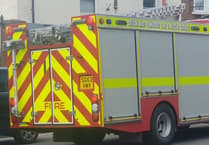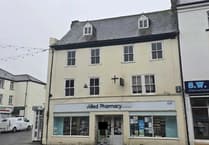Plans have been lodged for the interior transformation of an impressive part of Tavistock’s historic architecture.
Architects have lodged plans with West Devon Borough Council for the conversion of the former Barclay’s Bank at number six Bedford Square from a commercial financial unit to a mixed-use development of commercial and residential space.
The former bank occupies a corner site at the junction of Bedford Square and North Street and comprises a three-storey ornate stucco building incorporating a commercial unit on the ground floor.
Listed building consent is sought for alterations to enable change of use to mixed use building consisting of three ground floor commercial units and three first and second floor apartments including partial demolition to create a new entrance.
The current proposals have been prepared by Ayres Haynes Architects of Plymouth.
Although little remains of the former interior living accommodation and pre-banking use, externally the building still exhibits its status within the nineteenth historic commercial core of the town.
A report with the planning application states: “The building was erected when the town was thriving, it stands to complement the legacy of the vision of the 7th Duke of Bedford and his advisors. It has good quality architectural embellishments which still survive... but sadly its interior has been significantly stripped of any redeeming historic features.
“Its original shopfront has been adapted some time ago, but the current arrangement does not detract from the overall quality and significance of the building.”
The building dates from around 1870, the early part of the central area of Tavistock being developed by the Duke of Bedford on the back of the prosperity generated by the mid-nineteenth century mining boom in the area.
At the time of No 6’s construction, the street had already seen the flamboyant and impressive design at number one Bedford Square, built in 1830, apparently designed by the reputed architect John Foulston.
No 6’s design alsoreflects the grandeur that the Duke of Bedford was aspiring to for this showcase area of the centre of town.
It is possible that the design of the North Street elevation, which is plainer, was reined in from that of the showier Bedford Square facade.
The building was not originally built as a bank but was adapted, with the frontage onto Bedford Square given rich Italianate detailing, designed to impress banking clientele.
The original bank front has been altered but the ionic pillars appear to be an original part of the building and the historic splayed entrance remains. The original main recessed entrance was in the centre of the Bedford Square frontage, overlooking the church.
There are remaining frontages of up to two separate shop entrances on North Street.
Internally the building largely retains its original structural layout, however much of its original fabric and room partitions were either altered or removed to create the bank.
The only internal historic detailing remaining is the decorative timber mouldings surrounding the first floor arched head windows.
Reminders of its later use as a bank can be found in two cash lifts between floors and the former strong rooms with security doors in the basement.



-Tavistock-Area-Support-Services-manager-and-Hannah-Hull-Bedford-Hotel-events-co-or.jpeg?width=209&height=140&crop=209:145,smart&quality=75)

Comments
This article has no comments yet. Be the first to leave a comment.